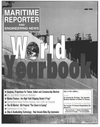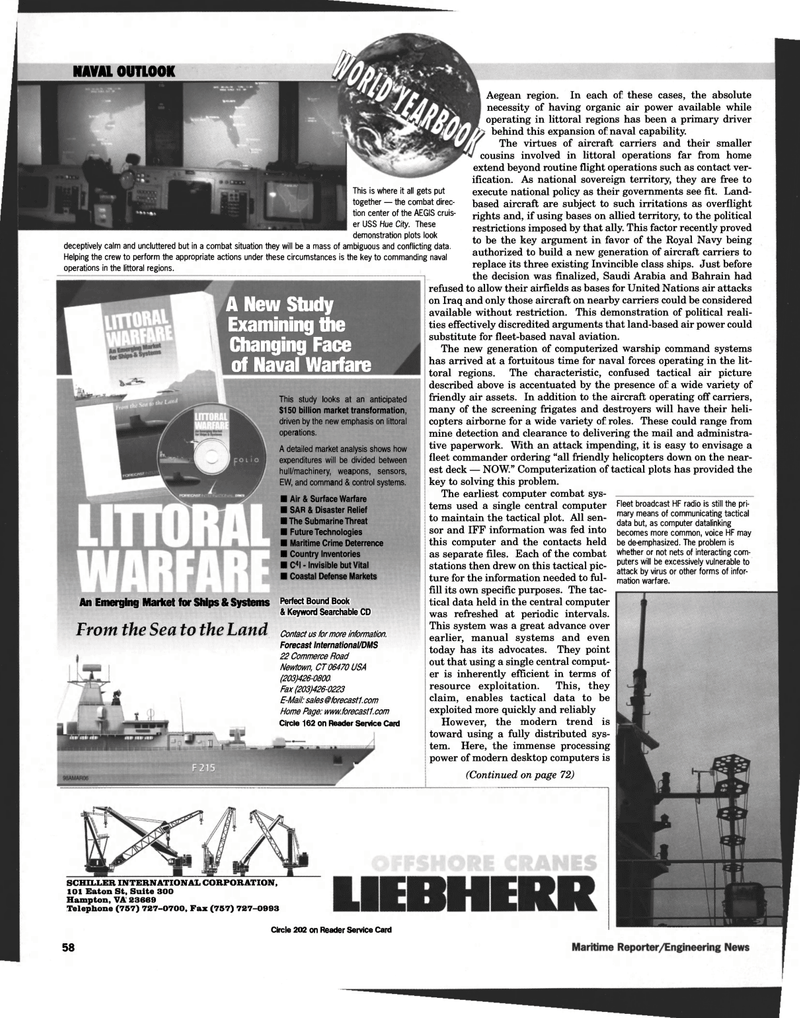
Page 83: of Maritime Reporter Magazine (June 1998)
Read this page in Pdf, Flash or Html5 edition of June 1998 Maritime Reporter Magazine
NAVAL OUTLOOK
This is where it all gets put together — the combat direc- tion center of the AEGIS cruis- er USS Hue City. These demonstration plots look deceptively calm and uncluttered but in a combat situation they will be a mass of ambiguous and conflicting data.
Helping the crew to perform the appropriate actions under these circumstances is the key to commanding naval operations in the littoral regions.
A New Study
Examining the
Changing Face of Naval Warfare
An Emerging Market for Ships & Systems
From the Sea to the Land
This study looks at an anticipated $150 billion market transformation, driven by the new emphasis on littoral operations.
A detailed market analysis shows how expenditures will be divided between hull/machinery, weapons, sensors,
EW, and command & control systems. • Air & Surface Warfare 8 SAR & Disaster Relief • The Submarine Threat • Future Technologies • Maritime Crime Deterrence • Country Inventories • C4I - Invisible but Vital • Coastal Defense Markets
Perfect Bound Book & Keyword Searchable CD
Contact us for more information.
Forecast International/DMS 22 Commerce Road
Newtown, CT 06470 USA (203)426-0800
Fax (203)426-0223
E-Mail: sales @ forecast 1. com
Home Page: www.forecast1.com
Circle 162 on Reader Service Card
Aegean region. In each of these cases, the absolute necessity of having organic air power available while operating in littoral regions has been a primary driver behind this expansion of naval capability.
The virtues of aircraft carriers and their smaller cousins involved in littoral operations far from home extend beyond routine flight operations such as contact ver- ification. As national sovereign territory, they are free to execute national policy as their governments see fit. Land- based aircraft are subject to such irritations as overflight rights and, if using bases on allied territory, to the political restrictions imposed by that ally. This factor recently proved to be the key argument in favor of the Royal Navy being authorized to build a new generation of aircraft carriers to replace its three existing Invincible class ships. Just before the decision was finalized, Saudi Arabia and Bahrain had refused to allow their airfields as bases for United Nations air attacks on Iraq and only those aircraft on nearby carriers could be considered available without restriction. This demonstration of political reali- ties effectively discredited arguments that land-based air power could substitute for fleet-based naval aviation.
The new generation of computerized warship command systems has arrived at a fortuitous time for naval forces operating in the lit- toral regions. The characteristic, confused tactical air picture described above is accentuated by the presence of a wide variety of friendly air assets. In addition to the aircraft operating off carriers, many of the screening frigates and destroyers will have their heli- copters airborne for a wide variety of roles. These could range from mine detection and clearance to delivering the mail and administra- tive paperwork. With an attack impending, it is easy to envisage a fleet commander ordering "all friendly helicopters down on the near- est deck — NOW." Computerization of tactical plots has provided the key to solving this problem.
The earliest computer combat sys- tems used a single central computer to maintain the tactical plot. All sen- sor and IFF information was fed into this computer and the contacts held as separate files. Each of the combat stations then drew on this tactical pic- ture for the information needed to ful- fill its own specific purposes. The tac- tical data held in the central computer was refreshed at periodic intervals.
This system was a great advance over earlier, manual systems and even today has its advocates. They point out that using a single central comput- er is inherently efficient in terms of resource exploitation. This, they claim, enables tactical data to be exploited more quickly and reliably
However, the modern trend is toward using a fully distributed sys- tem. Here, the immense processing power of modern desktop computers is (Continued on page 72)
Fleet broadcast HF radio is still the pri- mary means of communicating tactical data but, as computer datalinking becomes more common, voice HF may be de-emphasized. The problem is whether or not nets of interacting com- puters will be excessively vulnerable to attack by virus or other forms of infor- mation warfare.
SCHILLER INTERNATIONAL CORPORATION, 101 Eaton St, Suite 300
Hampton, VA 23669
Telephone (757) 727-0700, Fax (757) 727-0993
Circle 202 on Reader Service Card 58

 82
82

 84
84
